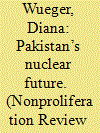| Srl | Item |
| 1 |
ID:
149317


|
|
|
|
|
| Summary/Abstract |
In April 2016, India took a momentous step forward in its quest to complete the nuclear triad.11. This article is derived in part from an earlier work by this author: Diana Wueger, “Deterring War or Courting Disaster: an Analysis of Nuclear Weapons in the Indian Ocean,
|
|
|
|
|
|
|
|
|
|
|
|
|
|
|
|
| 2 |
ID:
171173


|
|
|
|
|
| Summary/Abstract |
In 2019, the geostrategic landscape of South Asia significantly changed. A crisis between India and Pakistan involved air strikes across international boundaries for the first time since the 1971 war. Pakistan came close to economic collapse, while India re-elected hawkish Narendra Modi as prime minister in a landslide. These developments, alongside the United States’ efforts to strike a deal to leave Afghanistan and rapidly improving US-India relations, portend new challenges for Pakistan’s security managers—challenges that nuclear weapons are ill-suited to address. Despite the shifting security and political situation in the region, however, Pakistan’s nuclear posture and doctrine seem unlikely to change. This article explores the roots of Pakistan’s reliance on the traditional predictions of the nuclear revolution, most notably the notion that nuclear-armed states will not go to war with one another, and argues that this reliance on nuclear deterrence is a response both to Pakistan’s security environment and to serious constraints on moving away from nuclear weapons toward an improved conventional force posture. Pakistan’s central problems remain the same as when it first contemplated nuclear weapons: the threat from India, the absence of true allies, a weak state and a weaker economy, and few friends in the international system. While 2019 may have been a turning point for other states in the region, Pakistan is likely to stay the course.
|
|
|
|
|
|
|
|
|
|
|
|
|
|
|
|